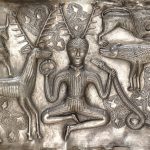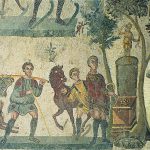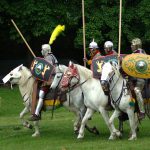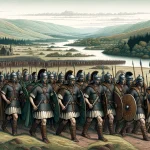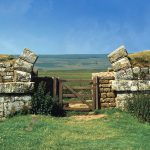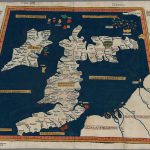Westerwood Roman Fort
Antonine Wall Fort
Westerwood is a Roman fort abutting the Antonine Wall, excavated in 1932, 1974 and 1985-8. The fort measures 300 ft. north-south by 280 ft. east-west (91 x 85 m) and covers an area of just under 2 acres (0.78 ha). The northern defences were formed by the rampart wall and ditch of the Antonine Wall, the rampart on the other three sides were of turf set upon a stone foundation generally 16 ft. (4.9 m) wide except at the south-east where it was only 14 ft. (c.4.3 m) in width, fronted by two ditches on all sides except on the extreme NW where there were three. The entrances in the north and south sides are both more-or-less centrally placed, but the gates in the east and west sides, through which ran the Military Way behind the wall, were displaced to the north about a third of the distance from the rampart wall.
Only two coins have been recovered from the area, a sestertius of Galba (reputedly from the site of the fort) and a denarius of Hadrian found on the Military Way near Arniebog in 1866.
There are two temporary camps nearby at Garnhall (NS7877) and another one at Tollpark (NS7777).
RIB 3504 - Altar dedicated to the celestial Silvanae and Quadriviae
Sacred to the celestial Silvanae and Quadriviae. Vibia Pacata, (wife) of Flavius Verecundus centurion of the Sixth Legion Victrix, with her family paid her vow willingly, deservedly.
QVADRVIS CA[.]
LESTIB ▸ SACR
VIBIA PACATA
FL ▸ VERECVṆḌI
𐆛 LEG ▸ VI ▸ VIC
CVM SVIS
V S ▸ L M
1–2. The Silvanae were wood nymphs, Quadriviae the goddesses of cross-roads; although they were worshipped separately, their conjunction occurs in Upper Pannonia, for example CIL iii 4441 = ILS 3574, marking the repair of their joint shrine at Carnuntum in 211. The form Quadruae is probably due to the instability of the intervocalic v. 2–3. ca[e]lestib(us). This epithet is applied to various deities, for example Brigantia at Corbridge (RIB 1131), but it strongly suggests dea Caelestis, the Punic Tanit of North Africa who was equated with Juno; compare RIB 1791+add. (Carvoran). 4. The dedicator’s cognomen is popular in Gaul, but is notably common in North Africa; in view of the associations of caelestis, this may be her origin, which would imply that she married her husband when he was serving in Legion III Augusta. 5–6. The centurion’s name is not distinctive, but in view of the Pannonian associations of the conjoint deities (see above, 1–2), Birley identifies him with T. Flavius Verecundus of Claudia Savaria, centurion of Legion XIIII Gemina Martia Victrix, who dedicated an altar to Mithras at Carnuntum (CIL iii 4416). His post at Westerwood is not stated, but he was probably praepositus (acting-commander) of an auxiliary unit like the centurion Flavius Betto at Rough Castle (RIB 2144).
RIB 2157 - Fragmentary dedication
For the use of nux in phallic contexts see Pliny N.H. xv 86: nuces iuglandes … nuptialium Fescenninorum comites.
References for Westerwood
- The Roman Wall in Scotland by Sir George MacDonald (Oxford, 2nd Ed. 1934) pp.253-8;
- The Roman Inscriptions of Britain by R.G. Collingwood and R.P. Wright (Oxford 1965);
- A Survey of the Coin Finds from the Antonine Wall by Richard Abdy in Britannia xxxiii (2002) pp.189-217.
Roman Roads near Westerwood
Antonine Wall: E (2.5) to Castlecary (Central) Antonine Wall: W (2) to Croy Hill (Strathclyde)
Sites near Westerwood Roman Fort
- Dullatur Camps (2 km)
Marching or Temporary Camp - Tollpark Camp (2 km)
Marching or Temporary Camp - Garnhall Temporary Camp 2 (2 km)
Marching or Temporary Camp - Garnhall Temporary Camp 1 (3 km)
Marching or Temporary Camp - Croy Hill Roman Fort (3 km)
Antonine Wall Fort and Vicus - Castlecary Roman Fort (3 km)
Antonine Wall Fort - Croy Hill Fortlet (3 km)
Antonine Wall Fortlet - Dalnair Temporary Camp (5 km)
Marching or Temporary Camp - Seabegs Wood Roman Fortlet (5 km)
Antonine Wall Fortlet, Fortlet and Marching or Temporary Camp - Bar Hill Fort Roman Fortlet (5 km)
Antonine Auxiliary Fort (AD 138–161)


